- Established 1982 -HOME: www.hiltonpond.org
THIS WEEK at HILTON POND Subscribe for free to our award-winning nature newsletter (Back to Preceding Week; on to Next Week) |
2020 BIRD BANDING SUMMARY: --THUMBNAIL RESULTS-- At Hilton Pond Center we arbitrarily established 2,000 as a realistic round-number goal for how many birds we'd like to band each calendar year. We achieved that goal for the 16th time in 2020, which finished as our 13th most productive year since 1982 with 2,112 bandings--more than our 39-year average of 1,841. We banded 77 species in 2020, our best since 2002 and our 12th-highest ever; the average number of species banded per year at the Center is 65.3.
All text, maps, charts & photos © Hilton Pond Center The just-ended year's biggest numbers came from five species: House Finch (361, undoubtedly local residents and their offspring, photo above of banded early winter female); Pine Siskin (328, in their first winter irruption since 2015); Ruby-throated Hummingbird (289, a big rebound from last year, with photo below of breeding adult female bearing a gray "nest mark" ); American Goldfinch (125, but still less than half the 39-year average of 297); and Northern Cardinal (which continued a local rebound this year with 112 individuals). Just these five species combined for 1,215 individuals, or 58% of the 2020 yearly total.
All text, maps, charts & photos © Hilton Pond Center Another bright spot: We surpassed the 71,000 total-bird mark in our 39th year of avian research at Hilton Pond, reaching a grand total of 71,802 bandings by year's end. Since 1982 we have banded 127 species at the Center, but no new species in 2020. --END-OF-YEAR THANKS-- Hilton Pond Center for Piedmont Natural History and Operation RubyThroat: The Hummingbird Project could not implement its banding program and other initiatives without the generosity of individuals who donate in support of our work in environmental education, conservation, and natural history research. We acknowledge these financial gifts throughout the year at the end of each installment of "This Week at Hilton Pond." In 2020 we were particularly grateful for contributions from the following "Top Tier Sustaining Donors": Marie Baumann, Ramona & Jim Edman, Lynn & Terral Jordan, Mary Kimberly & Gavin MacDonald, and Gail & Tom Walder--all citizen science alumni of one or more Operation RubyThroat Neotropical hummingbird expeditions--plus Scott Cronk, Pat & Robby Bryant, and Merike Tamm. Sincere thanks to them and to everyone else for such thoughtful generosity. All text, maps, charts & photos © Hilton Pond Center
All text, maps, charts & photos © Hilton Pond Center --BACKGROUND INFO-- The 2020 banding period was quite different from our norm at Hilton Pond Center. The year started slowly, with just 304 bandings during the first three months. Spring migration never really materialized, so we caught few northbound birds in April and May. Summer 2020 wasn't much better, with many days of rainy or very-hot-and-humid conditions.Autumn 2020 turned out to be a fairly productive time for banding, with a wide variety of birds and record numbers for some species such as Northern Parulas, American Redstarts, and Rose-breasted Grosbeaks (female above). And then early winter arrived at the Center, finally bringing an irruption of Pine Siskins and a productive final quarter of the year.
All text, maps, charts & photos © Hilton Pond Center By December's end, 2020 turned out to be one of our wettest years on record. Hilton Pond Center's digital rain gauge recorded a whopping 61.65" of precipitation, compared to a local annual average of about 44". The pond itself stayed nearly full for the entire 12 months--a phenomenon not previously seen in our 39 years on-site; this caused some water's edge trails and net lanes to remain unusable. Following several heavy rains, run-off from a neighboring farm brought in red clay sediment that stained the pond (above). Several times high water topped the spillway, creating a seldom-seen small stream that flowed into another impoundment 75 yards below Hilton Pond.
Monthly rain totals for 2020 are shown above. (Note that we had to replace the Center's 30-year-old weather station in September and may have missed a couple of rain events for that month.) Again, all this precipitation made it imprudent to run mist nets on many soggy days throughout the year, reducing the numbers of birds caught and banded.
We should mention specific spring and summer storms also had major and saddening impact on 2020 banding activities at the Center. On Easter Monday (13 April) a beloved 100-plus-year-old, 100-foot-tall Northern Red Oak (above) came crashing down near our old farmhouse, missing the structure but wreaking havoc as it fell. Six mist nets were destroyed, and established net lanes we had been using for more than three decades were obliterated; furthermore, numerous surrounding trees were snapped off, creating a huge "hole in the sky" where oak leaves once hosted millions of caterpillars that--in turn--fed hungry warblers, vireos, and other migratory species. It took weeks to reclaim the area enough to create new net lanes and get back to the business of banding birds. This was truly a devastating event that had immediate (and long-term) impact on our bird environmental research.
Five weeks later (22 May) an unexpected straight-line direcho whipped across Hilton Pond, toppling a big Black Walnut onto the roof of the Center's old farmhouse (above) while snapping branches from several other trees and tearing up two more mist nets. The only good news: Very minimal damage to the new roof installed barely six months earlier.
And finally, on 29 July, yet another windstorm tipped over tall twin Red Maples (above) that had been killed by drought, dropping them directly onto yet another net lane and destroying yet another mist net and pole set. All these storms absolutely affected our banding work AND had definite impact on the Center's finances when we had to find ways to cover the costs of replacing nine nets and their requisite poles and rebar anchors.
For the sake of bird welfare we don't open our nets at Hilton Pond when it's too hot for us OR the birds (above 90 degrees or so) . . . or below 40 degrees . . or when it's windy . . or in the rain. Thus, weather limits our work, and climatic differences year-to-year at the Center have definite impact on banding results. Regardless of weather, in 2020 we almost always ran a few sunflower seed traps all day for songbirds (locations A, B & C on the Center's plat, above); late March through mid-October we concentrated on trying to capture Ruby-throated Hummingbirds coming to sugar water traps dawn to dusk at those three locations. We do not tally net- or trap-hours at Hilton Pond Center. We find this accounting too complicated because of the way we have to operate, so we can't compare actual "banding effort" from one year to the next. However, despite any annual variations in bander activity we believe things "average out" over time, and our long-term banding studies still help us gain better understanding of nature trends here in the Carolina Piedmont. Year-to-year differences in work-hours DO affect our banding results, but of greater significance is the way the landscape at Hilton Pond Center has changed during 39 years we've worked and resided here.
Under our laissez-faire philosophy of land management, vegetational succession ensued and local habitats passed through stages, first from old field to shrubland (mostly invasives such as Chinese Privet and Russian Olive) and then to a dense stand of Eastern Red Cedar by about the 12th year. By Year 20 or so, many cedars were shaded out and killed by fast-growing deciduous trees, leading the transition to our current young forest of pine and sundry hardwoods with minimal shrubs or herbaceous ground cover. An aerial photo of Hilton Pond Center from March 2012 (above) shows how thoroughly the land had become covered by woody vegetation--mostly fast-growing Loblolly Pines on the north edge, and hardwoods between the two ponds and on the southern half and eastern end of the property.
Deciduous trees these days at the Center are quite diverse with lots of Winged Elm and Sweetgum; scattered throughout are Black Cherry, Green Ash, Hackberry, Flowering Dogwood, and various oaks and hickories. Just as vegetation has changed (current winter photo, above), so has local bird life; with regard to banding, many species that hung out in vegetation close to the ground where our mist nets could snare them now fly uncaptured in treetops high above.
All text, maps, charts & photos © Hilton Pond Center Speaking of vegetational change, Google Earth posted an aerial image from March 2018 that shows Hilton Pond Center's old farmhouse and the massive 150-year-old White Oak (above left) that toppled in October 2014. We feel quite certain loss of this ancient canopy tree had a negative impact on Center avifauna, but it was a natural occurrence. Just to the right of that big tree's base was the giant Southern Red Oak--still standing in the photo--that blew over in April of this year. On the positive side, absence of these two big oaks has created a new "hole in the sky" that provides a better view of sunsets AND of birds flying over.
Incidentally, on a year-round basis we offer local birds a LOT of food, primarily black oil sunflower seeds (above, with American Goldfinch, Carolina Chickadee, and Tufted Titmouse), plus white millet, cracked corn, shell corn, safflower, thistle (Nyger), dried mealworms, bark butter, shelled and unshelled peanuts, and various suet blocks. Our experiments with orange slices and grape jelly have failed to attract anything, including orioles. Spring through fall we hang at least two dozen feeders with sugar water for Ruby-throated Hummingbirds; in anticipation of western vagrant hummer species, we maintain a couple of these even during winter. (We have captured and banded two fall Rufous Hummingbirds locally through the years, one of which showed up a year later in Ohio!)
All text, maps, charts & photos © Hilton Pond Center Of equal or even greater importance than feeders, Hilton Pond itself and several smaller artificial pools near the old farmhouse provide places for birds and other wildlife to drink and bathe. Accessible clean water often brings in more birds than does food--especially in winter when some drinking sources are frozen solid. This is why at least one of our artificial water features is always equipped with a cold-weather heater (above, with three Eastern Bluebirds, a House Finch, two Northern Cardinals, and an American Goldfinch). All text, maps, charts & photos © Hilton Pond Center --2020 BANDING DETAILS-- All text, maps, charts & photos © Hilton Pond Center (Click on chart above for a larger version in a new browser window) As depicted on the chart above (click on it and any chart below to open a larger version in a new browser window), 2020 ended with 2,112 birds banded from 77 species for Hilton Pond Center. These numbers were above the 39-year average of 1,841.1 individuals (dotted white line) and the species average of 65.3. (Dotted red and blue trend lines on the chart show an on-going moderate decline in both these categories.) This year's bird total was slightly more than half of what we caught in our most productive year of 1991 (4,061 individuals), and diversity in 2020 was well below the 95 species we caught that same year. At least some of this discrepancy between our first 12 or so years and today resulted from that big shift in vegetational cover noted previously; in the mid-1990s the Center's open areas were becoming dominated by tall shrubs and young trees. It's likely epidemic West Nile Virus in that decade also took its toll, especially on birds such as Blue Jays, Eastern Towhees, Northern Cardinals, and various sparrows. (NOTE: Surveys in many locales near and far show fewer birds in the world due to diverse factors, from uncontrolled hunting to environmental toxins, and from climate change to devastatingly efficient free-roaming cats. As always, the biggest problems appear to be human-factors, especially habitat loss.) These days, shrub-loving birds like Gray Catbirds, Brown Thrashers, and many sparrows are quite scarce around Hilton Pond. Such species that prosper along edges and in shrub-dominant landscapes rather than in woodlands or open meadows showed drastically diminished numbers after peaking during the "shrubby years" of the early 1990s. And Eastern Red Cedars--with dense foliage that provided shelter, nesting habitat, and berries for many species--got shaded out by successive hardwoods, perhaps leading to further avian decline. Flowering Dogwood drupes, Hackberries, and Sweetgum seeds are still available these days, but not many bird species can handle hard-shelled nuts from Black Walnuts, Pecans, oaks, and hickories that now are among the most common local fruits.
All text, maps, charts & photos © Hilton Pond Center It did not help our local bird life that back in 1995 an adjoining farmer to the north of the Center clear-cut about 45 acres of mature Loblolly Pines and converted his land to pasture for beef cattle (see archival aerial image above). This apparently was the cause for a nearly instantaneous drop in numbers of species that frequent pine lands, with populations declining drastically among numerous breeding species such as Blue Jays, Pine Warblers, and Brown-headed Nuthatches. All text, maps, charts & photos © Hilton Pond Center (Click on chart above for a larger version in a new browser window) Despite habitat disruption and vegetation change, we continue to capture a significant number of birds at Hilton Pond Center. As shown on the chart above, the Center's 26 most commonly banded species continue to be dominated by four "winter finches," plus Ruby-throated Hummingbirds. Two of those--American Goldfinches (11,590 bandings) and House Finches (1,178)--are remarkably close in number after 39 years, with Purple Finches (8,994) not far behind. Since leaping atop the totals list in 2014, goldfinches have kept the lead. All text, maps, charts & photos © Hilton Pond Center (Click on chart above for a larger version in a new browser window) Of the four winter finches, Pine Siskins are the least common with 3,631 bandings (see chart above). This irruptive species--which comes south only during winters when there is a particularly poor seed crop on its Canadian breeding grounds--finally showed up at the Center again in 2020 after a five year near-absence. This year our first siskins appeared on 17 October (far earlier than usual) and continued to frequent our feeders and traps until 328 bandings was our fourth-highest year ever. Surprisingly, those siskins nearly disappeared in December. Where they went we do not know, but it will be interesting to see if they return later in the winter of 2020-21. All text, maps, charts & photos © Hilton Pond Center (Click on chart above for a larger version in a new browser window) The House Finch population at Hilton Pond Center has stabilized in the past two decades after reaching highs in the mid-1980s through early 1990s (see chart above). During that period nearly all eastern HOFI were winter migrants from up north, their direct ancestors having been released on Long Island in 1940-41. (House Finches are native to the western U.S. but in the East have expanded in all directions from that original New York population. They are now established breeders in the Carolina Piedmont and are nearly ubiquitous in the lower 48 states.) In 2020 we saw an increase to 361 House Finches, up from the 39-year average of 287. All text, maps, charts & photos © Hilton Pond Center (Click on chart above for a larger version in a new browser window) Despite their position atop the list, the Center's American Goldfinches put in a relatively poor showing for the third year running with just 125 banded in 2020 (see chart above). Less than half the 39-year average of 297, this was our lowest goldfinch total since 1996 when banding was conducted only part of the year. We are at a loss to explain this recent downward trend--especially since recent years' data indicate the species had been breeding more commonly in our region. All text, maps, charts & photos © Hilton Pond Center (Click on chart above for a larger version in a new browser window) Purple Finches (see chart above) were completely absent during the winter of 2019-20 but finally appeared in early November 2020, resulting in just 48 bandings during the final two months. Most years our biggest members of this irruptive species don't arrive until after Christmas, so there's still plenty of time for them to put in an appearance at Hilton Pond Center.
All text, maps, charts & photos © Hilton Pond Center Folks often ask: "What's the most unusual bird you banded this year at Hilton Pond Center?" We're never quite sure how to answer except to look at numbers and respond with the name of a bird we seldom band. Using that criterion, the male Pileated Woodpecker (above) captured on 5 April would be 2020's "biggest rarity"--mostly because it was the SECOND ever banded locally--with less than ten local sightings since 1982! Our first capture of this species was 30 years ago in April 1990. Several other local rarities are shown below; for each we have banded fewer than 50 individuals in 39 years at the Center.
All text, maps, charts & photos © Hilton Pond Center Winter Wren (above). We banded one of these likely winter residents in mid-October 2020; only 17 total since first banding in 1991.
All text, maps, charts & photos © Hilton Pond Center Prothonotary Warbler (hatch-year male, above). We banded this one likely migrant in late August 2020 (although it was possibly from the nearby nest of a summer resident breeding pair); only 19 total since first banding in 1986.
All text, maps, charts & photos © Hilton Pond Center Bay-breasted Warbler (hatch-year male, above). One of these pass-through migrants was banded in early October 2020; only 19 total since first banding in 1985.
All text, maps, charts & photos © Hilton Pond Center Chimney Swift (above). Two of these summer residents (a confirmed local breeding species) were banded in 2020; only 20 total since first banding in 1983.
All text, maps, charts & photos © Hilton Pond Center Red-breasted Nuthatch (black-capped male, above). Two of this winter-irruptive species were banded on consecutive days in early October 2020; only 20 total since first banding in 1985.
All text, maps, charts & photos © Hilton Pond Center Kentucky Warbler (hatch-year, above). We banded one in early July 2020 (apparently from the local nest of a summer resident breeding pair); only 21 total since first banding in 1984.
All text, maps, charts & photos © Hilton Pond Center Black-throated Green Warbler (adult male, above). Three of these pass-through migrants were banded in early October 2020; only 24 total since first banding in 1987.
All text, maps, charts & photos © Hilton Pond Center Blue-winged Warbler (hatch-year male, above). One of these pass-through migrants was banded in early October 2020; only 25 total since first banding in 1984.
All text, maps, charts & photos © Hilton Pond Center Red-winged Blackbird (male, above). We banded one adult male on April Fools' Day 2020, likely a wintering bird on its way north (not a common breeder in the South Carolina Piedmont); only 28 total since first banding in 1982.
All text, maps, charts & photos © Hilton Pond Center Hairy Woodpecker (male, above). We banded one of these likely year-round residents in 2020; only 29 total since first banding in 1986.
All text, maps, charts & photos © Hilton Pond Center White-breasted Nuthatch (black-capped male, above). An amazing eight of this year-round resident species were banded in 2020 (previous record was four in 2005); only 32 total since first banding in 1984.
All text, maps, charts & photos © Hilton Pond Center Yellow-throated Vireo (hatch-year, above). One of these was banded in late September 2020 (likely as a migrant but possibly from a local nest); only 40 total since first banding in 1983. All text, maps, charts & photos © Hilton Pond Center (Click on chart above for a larger version in a new browser window) In 2020 we had eight species at Hilton Pond that surpassed or equaled their annual highs, including the previously mentioned Pileated Woodpecker and White-breasted Nuthatches. Gray-cheeked Thrushes (14 banded in 2020) also equaled their record set in 1993 and tied in 2002. Common among the record-breakers was Mourning Dove, for which 46 bandings in 2020 surpassed the old record of 44 set in 2009 (see chart above. As indicated by the red line, doves are one of few species showing significant overall increase at the Center.) All text, maps, charts & photos © Hilton Pond Center Barely eclipsing their previous highs for Hilton Pond were Scarlet Tanagers (15 banded, old record 13 set in 2007) and American Redstarts (58 banded, old record 57 set in 1991, as noted on the chart above. Redstarts showed a remarkable jump after more than 20 years of numbers often in single digits.)
All text, maps, charts & photos © Hilton Pond Center Like American Redstarts, two other migratory species lingered on at the Center in Fall 2020, allowing us to band them in record-breaking numbers. These were Rose-breasted Grosbeak (18 banded, surpassing the old record of five set in 2007) and Northern Parula (above, 20 banded, surpassing seven in 1991 and 2008). In addition to the eight record-setting species mentioned above, 49 others were banded at average or above-average numbers. (See chart at the end of the write-up for a complete list of 2020 bandings.) --2020 FOREIGN ENCOUNTERS, RETURNS & RECAPTURES-- Northern Cardinals, Carolina Chickadees, Tufted Titmice, Carolina Wrens, and Mourning Doves, among others, are year-round residents at Hilton Pond Center. We recapture many of them over and over again after banding. Other species are non-residents that migrate away after banding and return in a later season as excellent examples of precise site fidelity.
All text, maps, charts & photos © Hilton Pond Center Our furthest known flier on record was a brown Purple Finch (file photo above) of unknown age banded at the Center in Feb 2004 and encountered two months later at Monastery, Nova Scotia--where it had been killed by a cat. This was a sad way to end a northbound migration route that covered at least 1,275 straight-line air miles. Despite banding 71,802 birds during nearly four decades at Hilton Pond Center, only 65 individuals (14 species) have been encountered outside our home county of York, while an additional 43 (13 species) were reported from within the county. (Click on links to review either list in a new browser window.) We speculate such low foreign encounter rates are due in part to a relative scarcity of banders in the southeastern U.S. and because of the mostly rural nature of the Carolinas; fewer banders, fewer people, and large swaths of undeveloped land mean banded birds are less likely to be encountered.
All text, maps, charts & photos © Hilton Pond Center Although we had no foreign encounters of Hilton Pond birds outside York County in 2020, we did learn of two House Finches (male, file photo above) found dead within five miles of the Center. A male banded in May 2019 hit a window near Rock Hill in December 2020, and a female died of unknown causes less than a mile away in March 2020 after being banded two months earlier. Despite our low foreign encounter rate, many migratory birds banded at Hilton Pond Center have returned here in later years, providing valuable information about species longevity and site fidelity. (Of 127 species banded locally, 63 species have been recaptured locally in a later year. Some are year-round residents that have been caught dozens of times; others are migrants that return after spending one or more seasons elsewhere.) A few of Hilton Pond's more noteworthy recaptures/returns in 2020 are described below. Several individuals set or equaled longevity records for the Center. (Ruby-throated Hummingbird returns are discussed in a later section.)
All text, maps, charts & photos © Hilton Pond Center Although returns and local recaptures of birds banded at Hilton Pond Center frequently occur, foreign encounters of our birds are few. Even less common are recaptures here of birds banded elsewhere by someone else. Prior to this year we had re-trapped only nine foreign birds--five Purple Finches, three House Finches, and one American Goldfinch--all but one of these nine from banding stations far northeast of York SC. Furthest of these was a brown Purple Finch banded and released in Rhode Island (see map above) in October 2018 and recaptured at the Center in March 2019. (For a complete list, see Birds Banded Elsewhere and Recaptured at Hilton Pond.) All text, maps, charts & photos © Hilton Pond Center ••2020 RUBY-THROATED HUMMINGBIRDS•• All text, maps, charts & photos © Hilton Pond Center (Click on chart above for a larger version in a new browser window) Ruby-throated Hummingbirds (RTHU) rebounded nicely in 2020 at Hilton Pond Center after an unexplained downturn in banding results during the previous year (see chart above). For the 12th time we exceeded 200 bandings and had our third-most-productive season with 289, finishing well above our 37-year average of 180. (Note that because of special federal permit requirements RTHU research did not commence until July 1984--two years after other local banding activities began. Thus, 2020 is our 37th year for hummers.) All text, maps, charts & photos © Hilton Pond Center (Click on chart above for a larger version in a new browser window) The 2020 Ruby-throated Hummingbird research season started very slowly at Hilton Pond Center; its progress is marked by the red dotted line on the chart above. Our first new capture of an adult male RTHU on 14 Apr was nearly three weeks later than our early record of 27 March (in four different years), but this year our first adult female actually showed two days before that initial male. (Early spring males typically precede earliest females by 10-14 days.) By the end of April we had banded just three ruby-throats; this was an incredibly slow start to the hummingbird banding season, and things didn't start moving until June. By mid-July, however, the pace of new hummer bandings had increased to become one of the fastest ever and ended as our third-best season since 1984. We banded eight "late" ruby-throats in October, the last on the 7th. (Our all-time late record is 18 October.)
All text, maps, charts & photos © Hilton Pond Center The first 2020 return of a BANDED RTHU was an adult male with red gorget (above) on 29 March. The first returning female arrived about three weeks later on 20 April. (NOTE: In light of all these arrival dates for new and returning Ruby-throated Hummingbirds, we always suggest folks in our region hang--and maintain--at least one sugar water feeder by 15 March each year. Better to be early than too late.)
All text, maps, charts & photos © Hilton Pond Center All Ruby-throated Hummingbirds captured--or recaptured--at Hilton Pond Center are banded and then marked with a temporary green color mark (see female above). This helps us avoid recapturing "trap junkie" hummers that re-enter our pull-string and electronic traps over and over and over again. In spring it also means folks north of us can be alert for color-marked RTHU; in autumn observers to our south can be on the lookout. If you see ANY color-marked hummingbird, please report it to us immediately via e-mail at RESEARCH; a photo would be most helpful. All text, maps, charts & photos © Hilton Pond Center (Click on chart above for a larger version in a new browser window) (NOTE: On the chart above, AHY = after-hatch-yaer, or adult; HY = hatch-year, or immature.) By the end of any given breeding season at Hilton Pond Center we logically expect many more hatch-year RTHU among our banded birds. With each female typically producing two fledglings, the total population theoretically should at least double. (In reality, reproductive output of Ruby-throated Hummingbirds is far more complex; double- or even triple-brooding is possible and at least some males have a harem system with more than one female. Thus, at all but the most most northern latitudes the local population could more than double during the breeding season--assuming high fledgling survival prior to migration.) During 37 years of hummer banding (left pie chart, above), 72.2% of all ruby-throats banded have been recent fledglings (males in pale blue, females in pink); in 2020 (right pie chart) they made up significantly more at 79%. Our 135 hatch year males comprised nearly half (47%) of all bandings in 2020--above the 37-year average of 42.6%; 93 young females likewise resulted in a higher percentage (32%) than average (29.6%). Percentages for 23 adult males (8%; dark blue on pie charts) were noticeably lower in 2020 than the 37-year average of 11.8%. Such was also the case for 38 females (13%; in red), below the average 16.1%. All text, maps, charts & photos © Hilton Pond Center (Click on chart above for a larger version in a new browser window) Just as the Center's crop of NEW Ruby-throated Hummingbirds in 2020 was our third-best ever, it was also our fifth-best year for RETURNS of RTHU banded in previous breeding seasons (see chart just above). In fact, our 48 "old birds" was far above the 37-year average of 28.9. We did anticipate a bumper crop of returns in 2020 because of high numbers banded in 2016, 2017, and 2018. The dotted red trend line on the chart above shows RTHU returns are generally increasing at Hilton Pond Center--to be expected because our numbers of new bandings are also on the rise. On average, about 11% of all ruby-throats we band locally return in at least one later year--a substantial subset when we consider that an estimated 60% to 80% of young hummers produced each year do not survive due to disease, genetic defects, predators, environmental dangers, or rigors of migration down and back. (It may also be that some Ruby-throated Hummingbirds banded at the Center disperse to other nearby areas, never again to be seen locally after banding.)
All text, maps, charts & photos © Hilton Pond Center Of this year's 48 RTHU returns in 2020 at Hilton Pond Center (see list below), 26 were banded last year (2019), 11 in 2018, five in 2017, four in 2016, and two in 2015. The apparent oldest were two females banded in 2015--one as a recent fledgling now six years old, and the other as an adult in at least her seventh year. (The latter female could actually have been even older; the Bird Banding Lab's record for oldest free-flying Ruby-throated Hummingbird is 9+ years.) TABLE 1: 48 "Old" Ruby-throated Hummingbirds Returning in 2020
Several individuals highlighted in GREEN on the list above were not recaptured each and every year after being banded. These hummers were absent from our nets and traps one year or more, only to show up again in 2020. (Most interesting is the female banded as an adult in August 2016 but not encountered again until this year.) Because many Ruby-throated Hummingbirds may show strong site fidelity to their natal/breeding grounds, it's likely these hummers were in the neighborhood each year and simply avoided recapture. Perhaps the most striking thing about the list above is that of 48 Ruby-throated Hummingbirds returning in 2020 only four were males (highlighted in BLUE)--and only one of those had been banded as an adult. This is difficult to explain, but we have considered three possibilities below, the second of which we believe is most likely. (We'd be happy to entertain other hypotheses. If you have one, please click here to send an e-mail to us at INFO.)
All text, maps, charts & photos © Hilton Pond Center One final note about our Ruby-throated Hummingbird returns in 2020: Only two had been banded in September and none in October during previous years--a phenomenon that happens regularly at the Center. We suspect this occurs because the vast majority of late-summer bandings are young birds (color-marked hatch-year male, above, with partial red gorget) that very well may be pass-through migrants from points further north. If these individuals survive their first southbound migration, its possible they return to some distant natal range rather than to Hilton Pond. (Again, we welcome alternate hypotheses on this situation at INFO.)
All text, maps, charts & photos © Hilton Pond Center We have banded 6,644 Ruby-throated Hummingbirds since 1984 and have 1,070 total returns, with some individuals returning in more than one later year. Alas, only six of our Hilton Pond hummers have been seen elsewhere. Four color-marked RTHU were encountered during fall migration (see map above) in Atlanta, Louisiana, and Alabama (two individuals). Two spring migrants were reported from Massachusetts and Clover SC (the latter about ten miles north of the Center).
All text, maps, charts & photos © Hilton Pond Center ••2020 "YARD LIST" & NESTING SPECIES•• Our inventory of birds observed through the years on or over Hilton Pond Center rose to by two to 172 in 2020, when we decided--after much thought and subsequent discussion with our listing peers--to add Bobolink (male, above) and American Pipit to our "Yard List." Both have been sighted from Center property in a field just across the street and may (or may not) have flown over our 11 acres. Bobolinks were seen there during several past springs, but the pipits were new this year. (No other new species were observed in 2020.) During 2020 we saw or heard a total of 111 bird species at the Center--obliterating our record of 96 set in 2008. This year's tally was 15 more than last year and represented more than half (64%) the species observed locally since 1982.
All text, maps, charts & photos © Hilton Pond Center We find it interesting that of 38 North American Wood Warblers LIKELY to be seen at Hilton Pond Center, we have observed and banded 35 of them. The missing species are Cerulean Warbler (second-year male, above, which we banded in West Virginia in 2019) and Mourning Warbler--both of which typically migrate further inland and west of the Center--plus the endangered Kirtland's Warbler. (The other 14 extant North American parulids are western species not likely to occur in South Carolina's Piedmont Province. Bachman's Warbler--now extinct from the Carolina Lowcountry and elsewhere--can no longer be seen except in museums.)
All text, maps, charts & photos © Hilton Pond Center Among all species encountered at the Center since 1982 we've found nests for 25, including other birds that often lay their eggs in a box intended for Eastern Bluebirds (winter male and female above). A male Prothonotary Warbler even tried building a nest in a box with 1.5" hole before a dominant bluebird pair drove him away. All our boxes have been fairly effective and have been used by Tufted Titmice, House Wrens, and Carolina Chickadees. We've also installed several boxes with 1" diameter holes that exclude bluebirds but allow Brown-headed Nuthatches to enter. Boxes stay up year-round and sometimes serve as roost sites during cold weather; they occasionally are occupied by Southern Flying Squirrels.
All text, maps, charts & photos © Hilton Pond Center We have six much-larger nest boxes mounted on poles in the water around Hilton Pond itself. Complete with predator baffles, these structures are designed for Wood Ducks and have produced more than 800 ducklings since 1982 (see image above of perched hen with watchful drake swimming on Hilton Pond). NOTE: If you're not keeping a "Yard List" for your own property we encourage you to do so, and to report your sightings via eBird. The eBird Web site provides a great way for you to keep track of what you see and when, and it allows you to make valuable contributions to our body of knowledge about birds. You, too, can be an ornithological "citizen scientist." All text, maps, charts & photos © Hilton Pond Center ••2020 BANDING TOTALS•• A complete list of 2,112 birds of 77 species banded at Hilton Pond Center in 2020 is provided in the table below. Also shown are our 39-year maximums, averages, and grand totals for each species.
All text, maps, charts & photos © Hilton Pond Center We invite you to examine and dissect the table below for trends or to see whether we captured your favorite species--perhaps a Hermit Thrush like the one above that is banded and has been with us at the Center for six years in a row. For a running account of banding and recapture results for the just-completed year, please refer to lists at the end of each installment of "This Week at Hilton Pond," beginning with the one for 1-31 January 2020. There really is much to be said for long-term banding projects like ours that provide solid baseline data leading to better understanding of avian ecology. We're proud to report we've been at it since 1982 at Hilton Pond Center for Piedmont Natural History--still the most active year-round bird banding station in the Carolinas. All text, maps, charts & photos © Hilton Pond Center
All text, maps, charts & photos © Hilton Pond Center
|
|---|
|
"This Week at Hilton Pond" is written and photographed by Dr. Bill Hilton Jr., executive director of Hilton Pond Center for Piedmont Natural History
|
|
|
Please refer "This Week at Hilton Pond" to others by clicking on this button: |
|

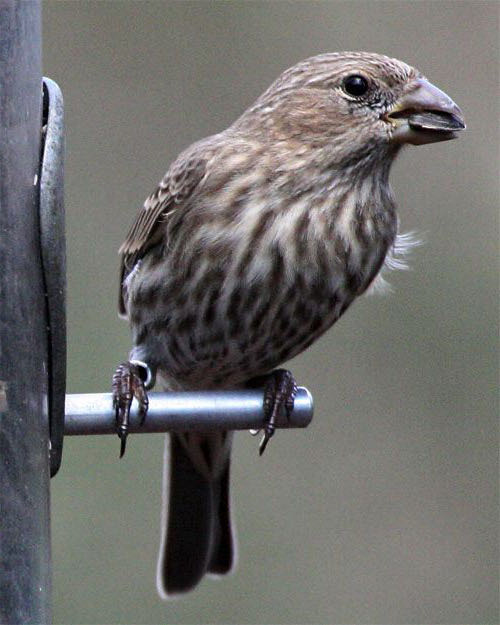
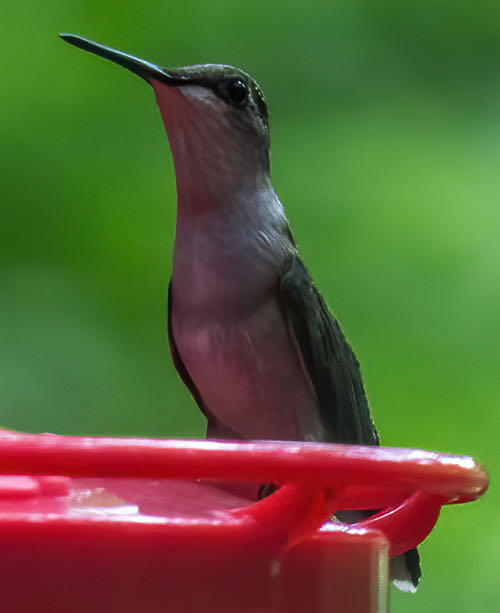
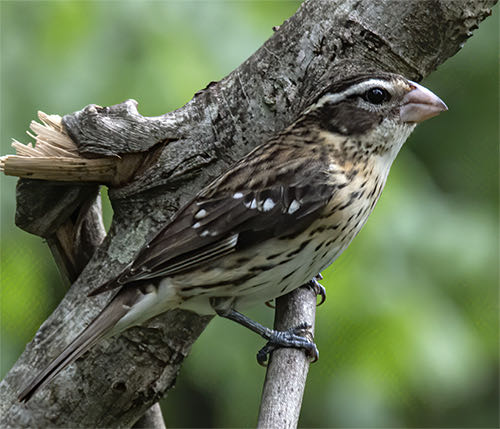
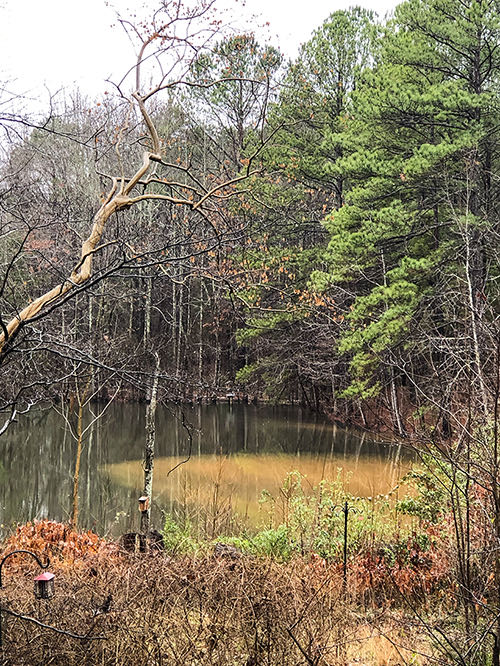
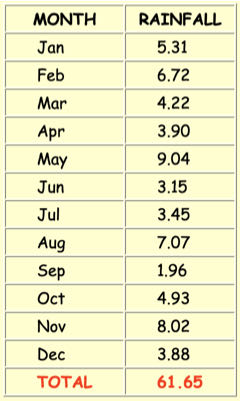
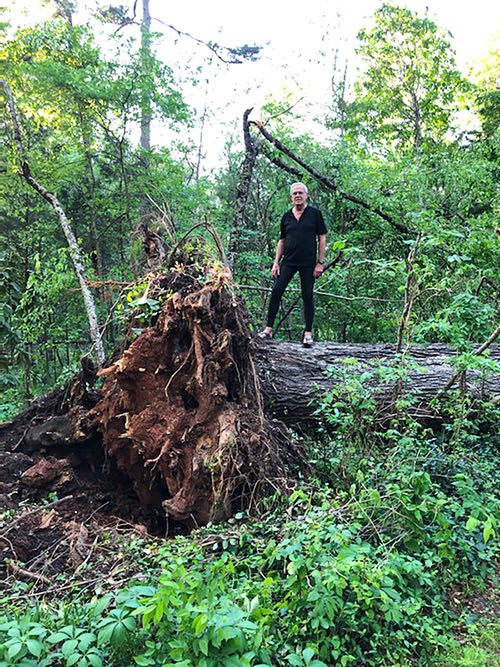
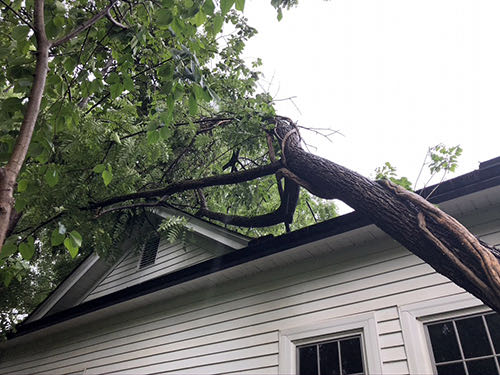
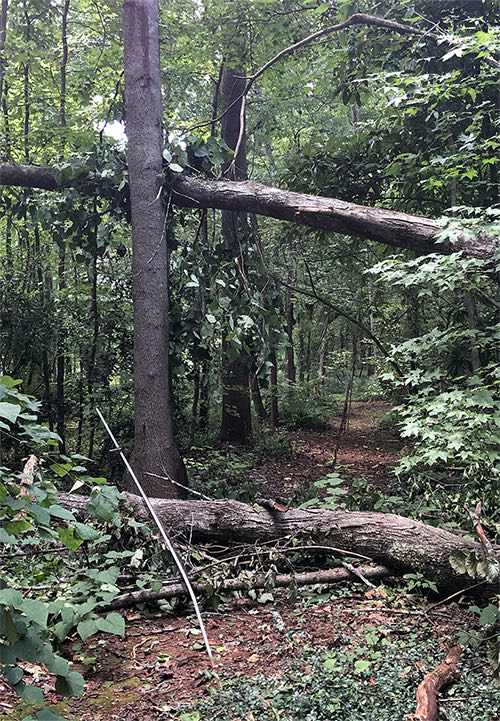
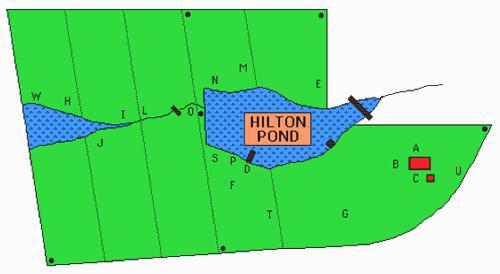
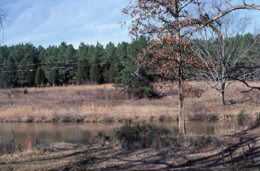 When we purchased our 11-acre plot in 1982 it was almost all open
When we purchased our 11-acre plot in 1982 it was almost all open 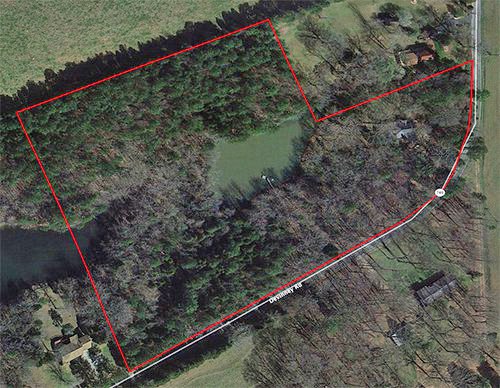
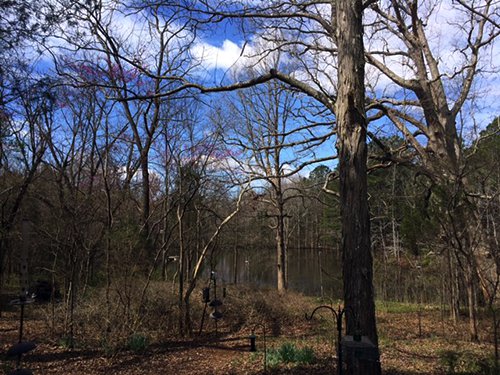
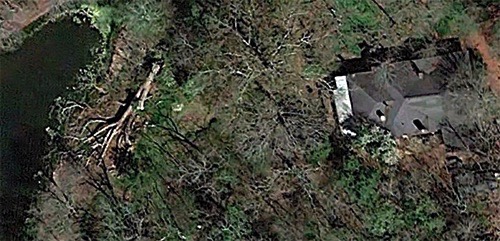
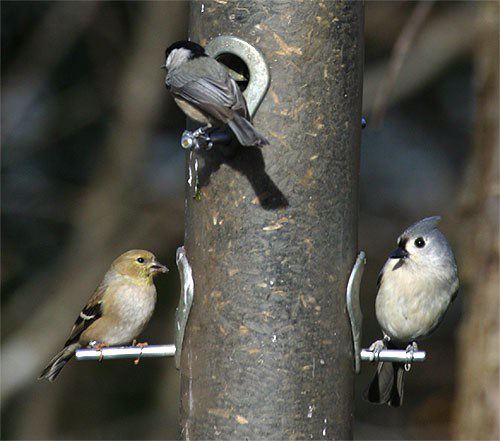
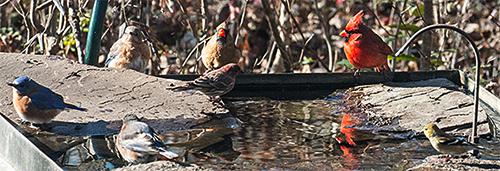
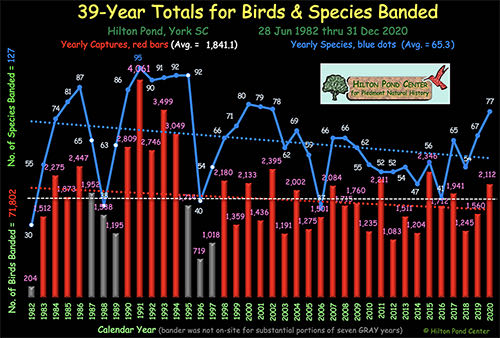
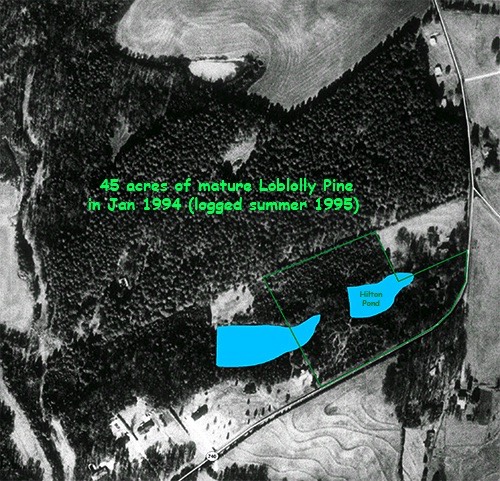
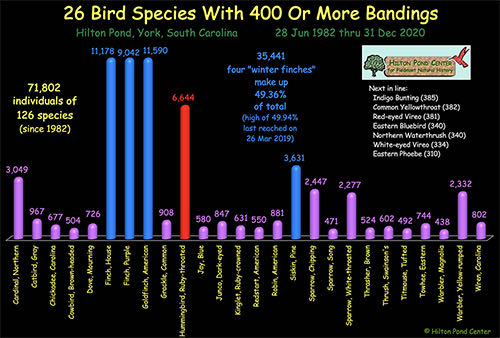
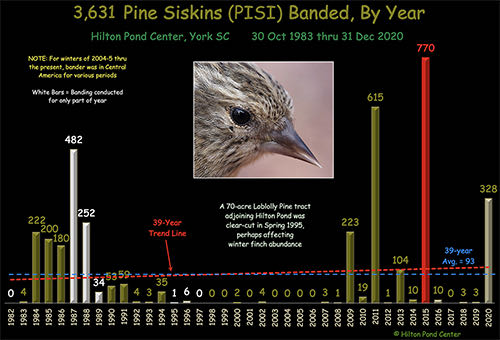
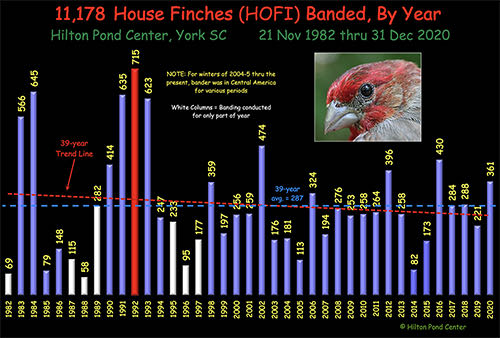
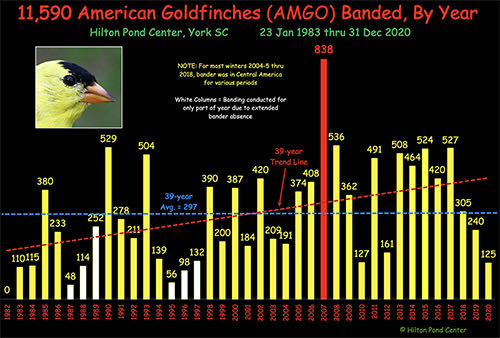
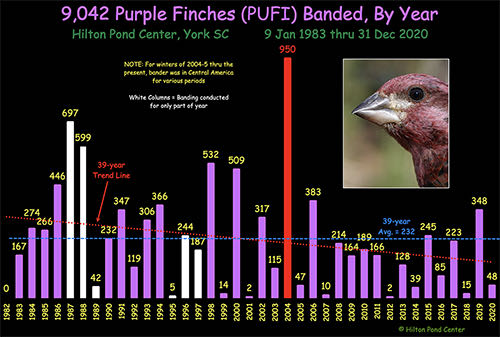
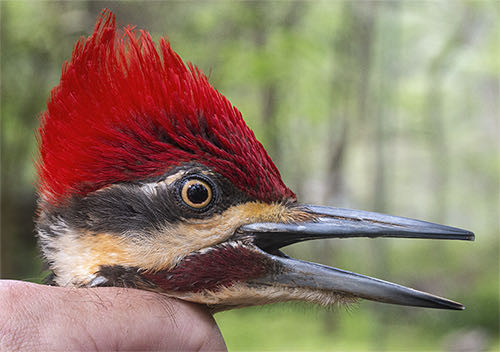
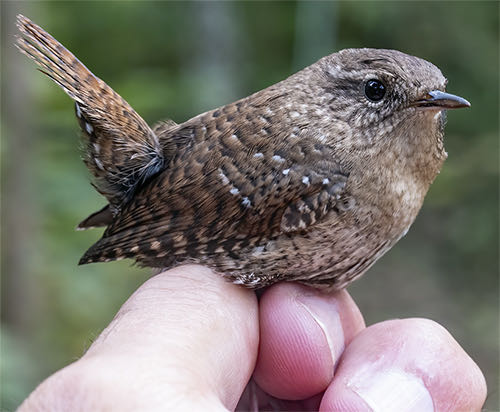
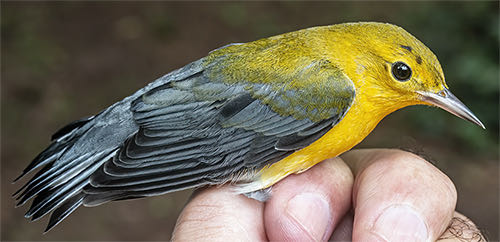
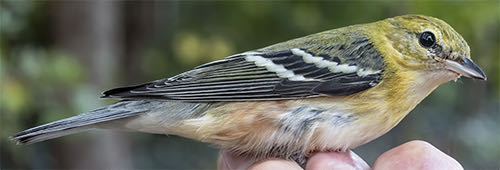
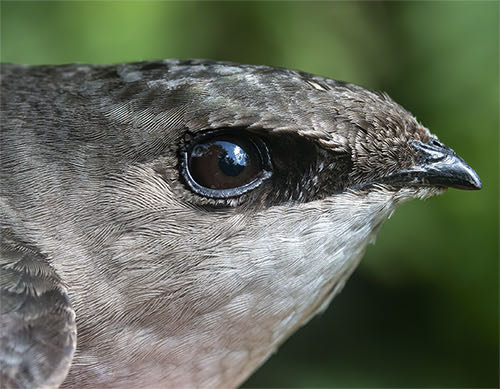
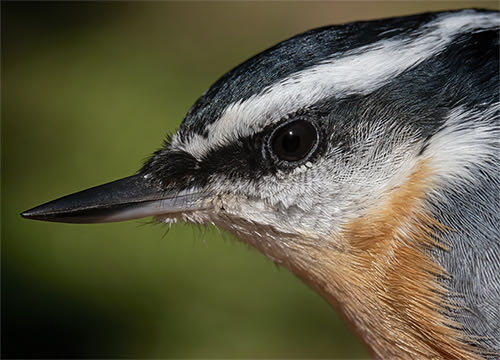
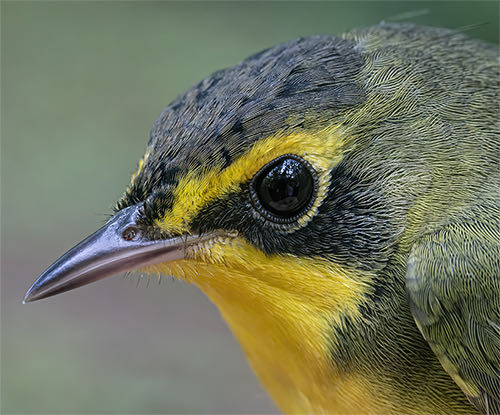
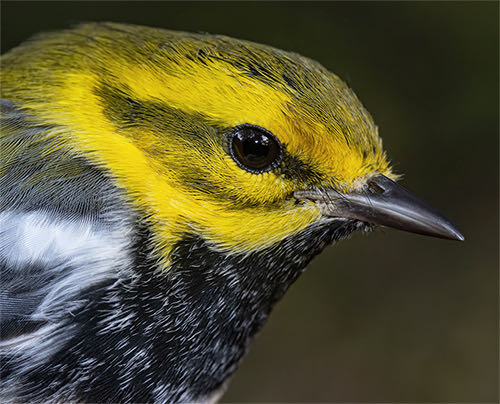
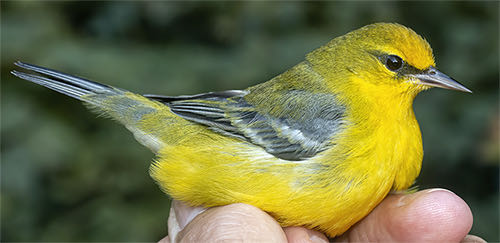
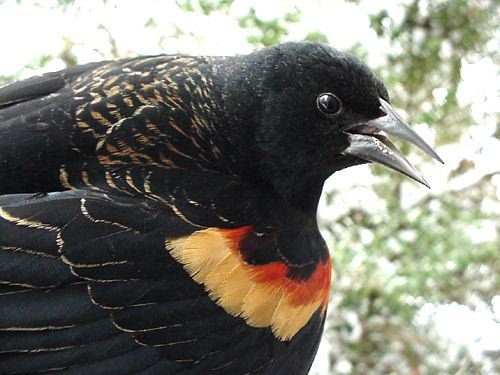
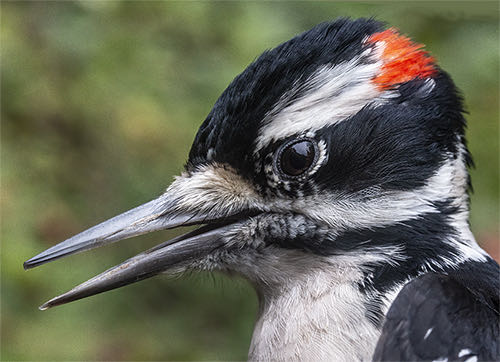
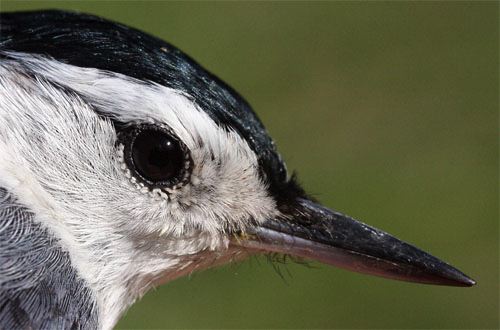
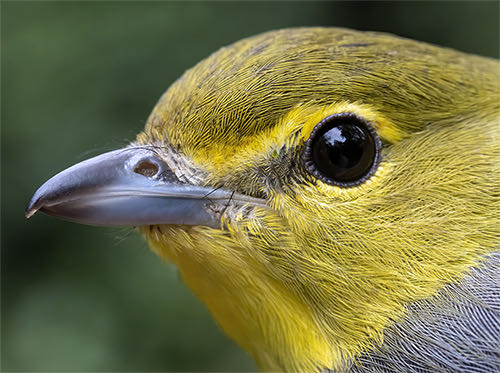
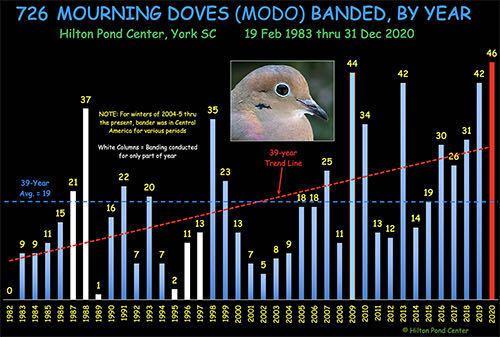
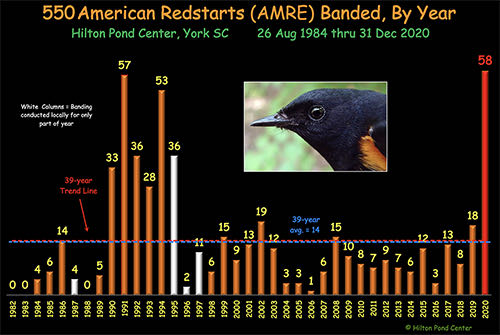
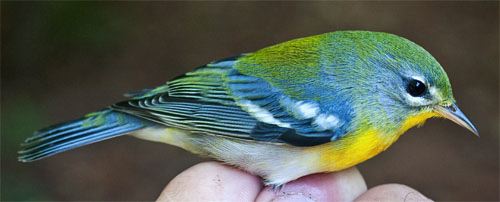
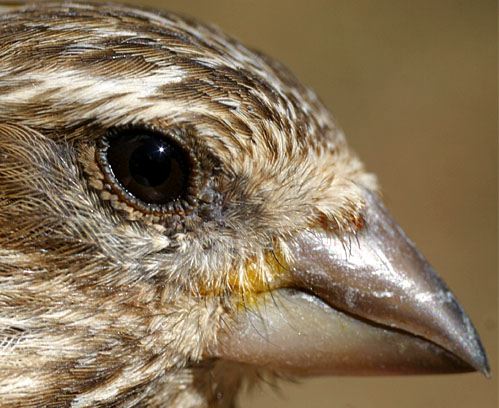
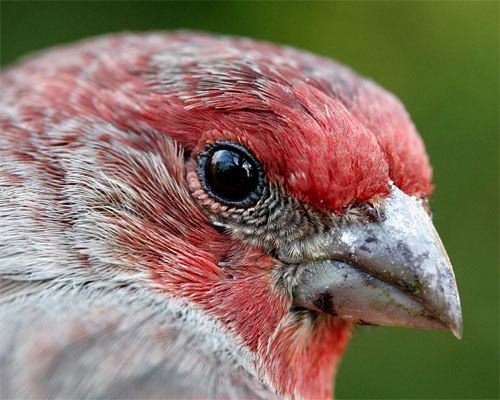
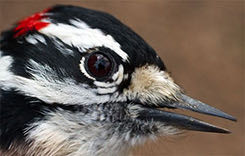 Resident male
Resident male 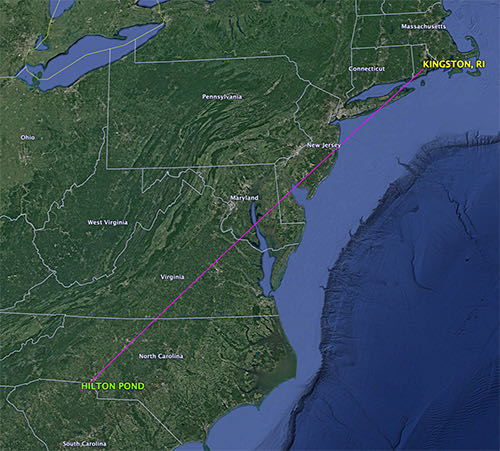
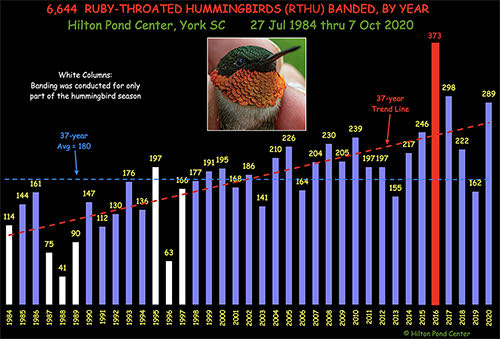
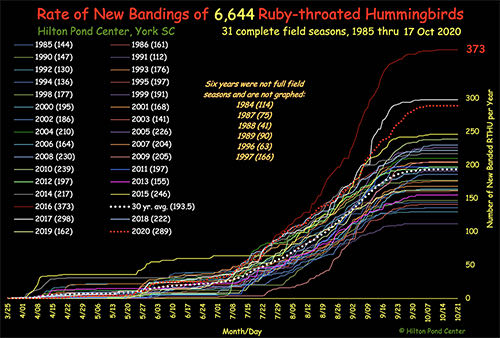
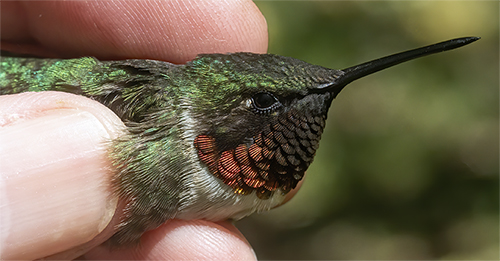
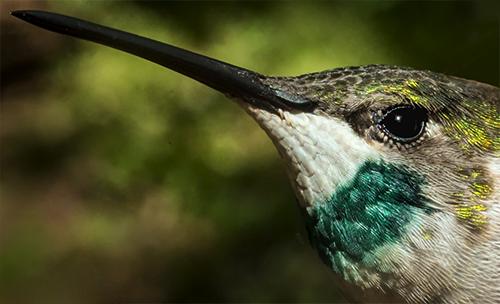
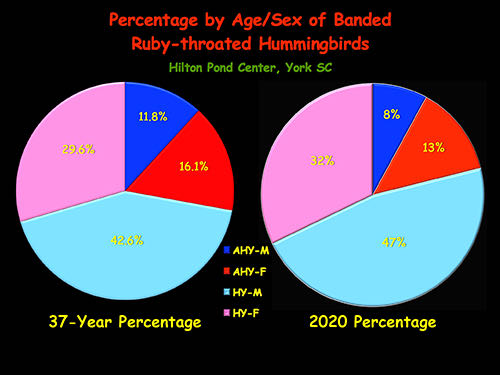
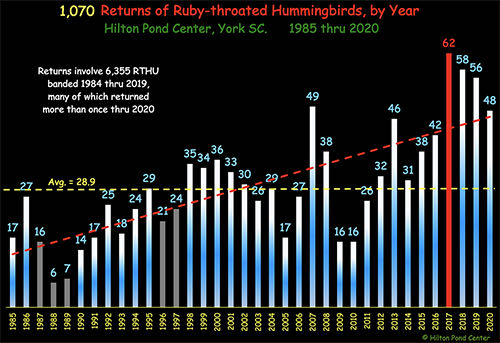
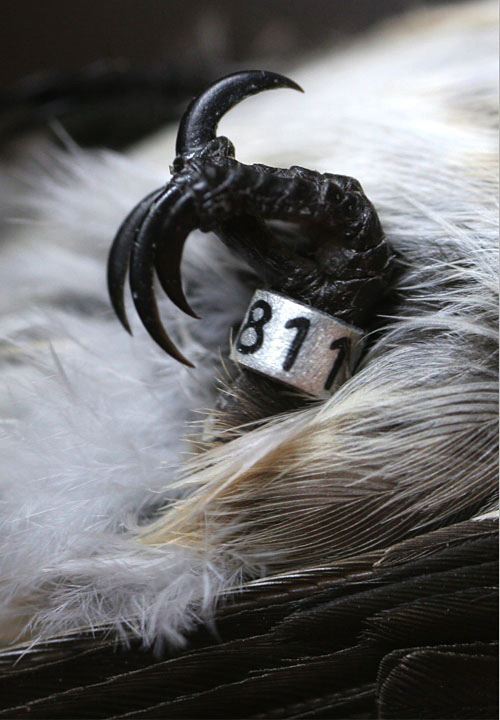
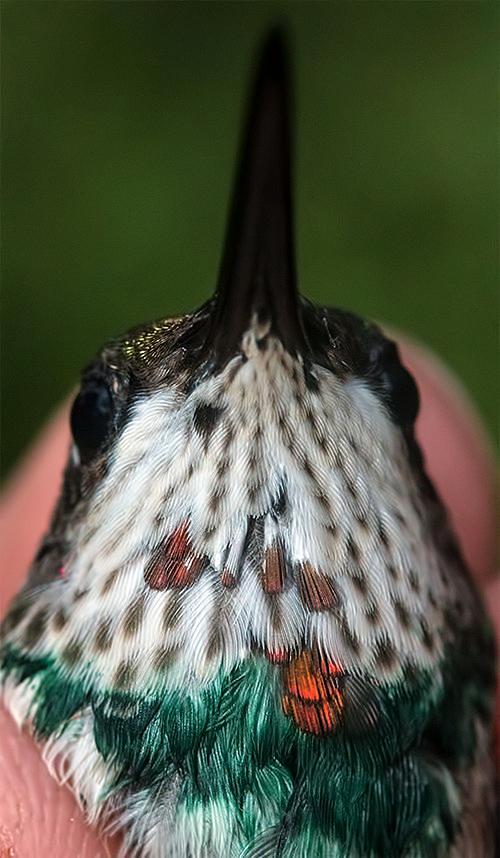
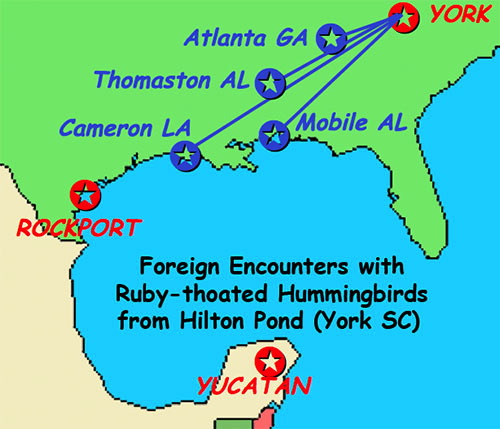
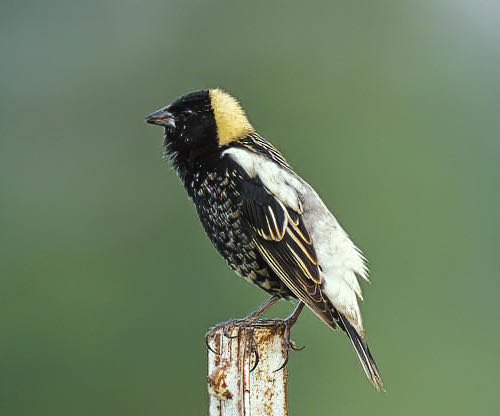
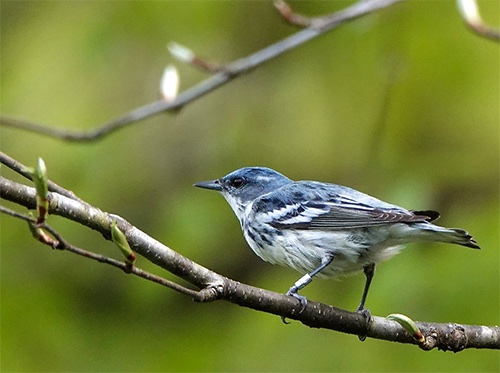
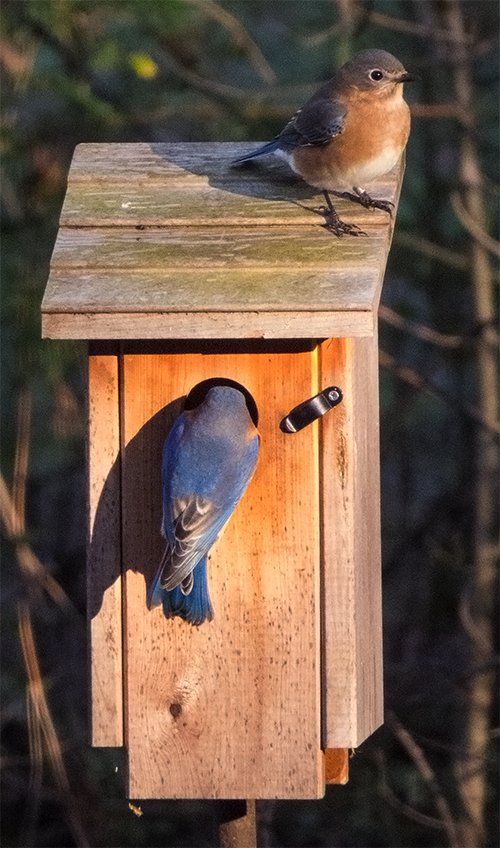
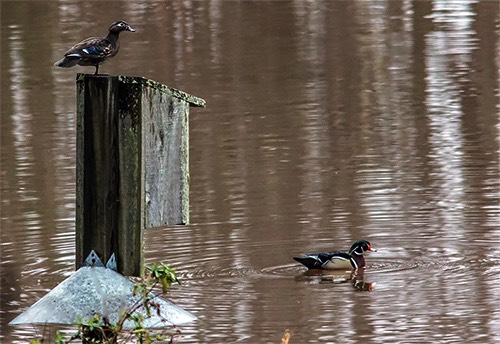
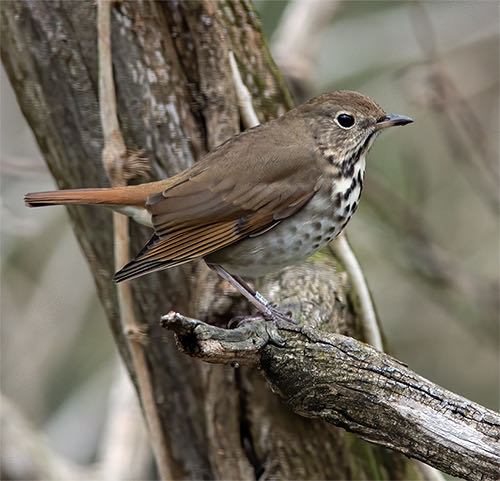










 Oct 15 to Mar 15:
Oct 15 to Mar 15: